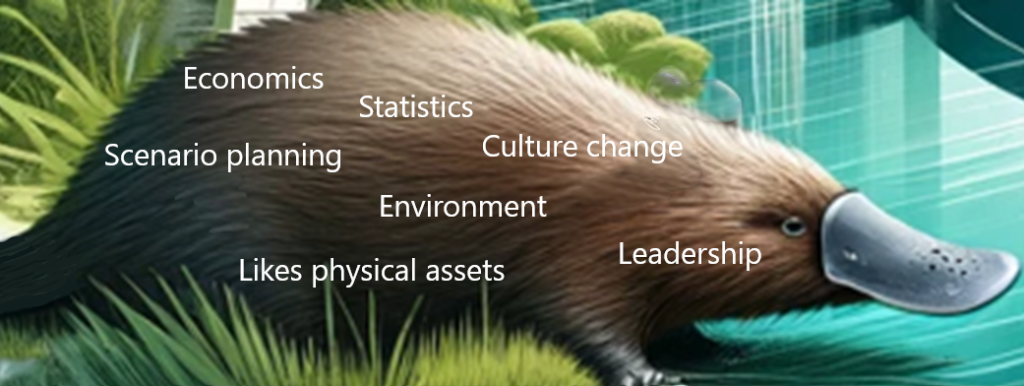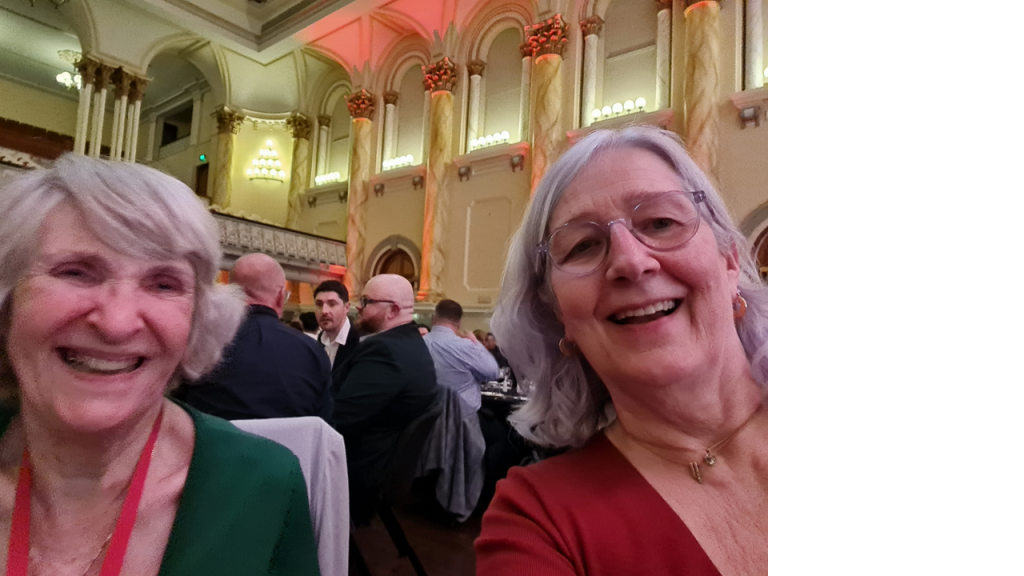
If Asset Management is to deliver better asset planning, we have a challenge. Are we living up to it?
The most obvious thing about AM is that it’s about physical assets. And for most of its history, the assumption has been that the main quality of an asset manager is that they need a background in those areas most concerned with physical assets: that is, engineering, operations, or maintenance.
Who else knows or cares about physical assets? And without that interest, AM might be unmoored: a branch of finance or corporate planning that simply doesn’t know or care enough.
The dilemma is that we need other skills that don’t come for free with delivery backgrounds.
Worse, we need perspectives that definitely go against what we learn in engineering school, or the motivation of operations.
- How do we nurture a profession of people who really like the realities of physical assets but think in a new way about them?
- How early do we need to reach potential asset managers?
There are some good signs – Dr Monica Beedles’ Street Smarts and Biz Smarts, for example, and the Canadian Network of Asset Managers (CNAM) work on AM competences. (And shout out to pioneers of new ways of getting to undergraduates – hello, Valerie Marcolengo!)
But, as CNAM points out, we have a chronic shortage of asset managers.
And many who struggle in post without the tools of effective asset management planning.
How do we reach those with the environmental, analytical, process, culture change and bigger picture skills we need?
What is your ideal undergraduate syllabus to grow the next generation of asset managers?
Thanks to the British Columbia South Island AM Community of Practice for the opportunity to discuss competences this week!

Now that we have a great many courses and various trainings in asset management it is tempting to say that all asset managers should be ‘qualified’. But thinking about this I reflected on my own experience, starting from nothing, and I also remembered an interesting dinner one night when a colleague reported that his daughter had an ambition to be an asset manager like him.
“You can only do what I do, if you do what I did” replied her father, explaining that his daughter would need to do an engineering degree and further study as he had done.
“Is that really true?” asked his wife, who had home-schooled their extremely bright children. “Could she not learn by observation and questioning and work her way up from simple to more complex tasks? That is the way she has learnt everything else!”
You and me and, indeed, many asset managers have learnt much of their asset management this way. It is only within the last ten or fifteen years that we have started to teach the processes and techniques of asset management – in seminars, workshops, and in formal education.
Some of you would have a graduate degree in engineering, others would have come up through a background of construction, maintenance, finance, or property development/ management and may, or may not, have formal tertiary qualifications.
A couple of the best asset managers I have known had qualifications — but in nursing! One became Director of Capital Works in a Health Commission, the other an extremely practical policy director in the Commonwealth Government. They really understood the concept of service.
Or consider the Asset Manager I lunched with, who designed and published much sought after practical guidelines in asset management, decision making and life cycle costing, all without the background of a formal degree – just an inquiring mind, the interest to read widely, and the wit to apply what he read. He was, moreover, able to teach these techniques to others who also had no formal training and to design policy that encouraged their use. Now that IS an Asset Manager!
When we consider the number of excellent engineers we know, great at ‘doing’ things, but with little real interest in decision-making, then we would have to conclude that an engineering background may be useful but it is neither necessary nor sufficient.
“But surely we have to have properly qualified people?” Sure, but how do you qualify people to look for better ways to do what has always been done, indeed, better ways to do what they, themselves, have been taught to do? Qualifications and ability are not synonymous. We need to be more flexible and mandating certain qualifications or training will only hinder flexibility.
So yes, keep learning, get qualifications, but in a fast changing world, no set of qualifications can be allowed to be a stopping place. Or to stop us

What makes an effective asset management practitioner? Ruth Wallsgrove ,who founded IAM’s Asset Magazine in 2004, recently contributed this opinion piece to the magazine in which she shared some of her experience in working around the globe. Our thanks to IAM for permitting reproduction here.
On the steering group to review the IAM Competences Framework, we discussed the distinction between the things we needed to know about and things we actually have to be able to do for ourselves. That is between what we need to appreciate other people doing, and what we have to take main responsibility for.
A useful way I have found to think about asset management capabilities generally is: what won’t get done if we don’t do it? What key competences should we expect not to be there, if we don’t have them?
This means areas such as IT, Engineering and Finance are fields we should understand, but we don’t necessarily need to have hands-on skills or previous experience in them. There are plenty of other people, other professionals, looking after them.
On the other hand, we have to be the ones to understand good asset management practice, and to communicate this and its benefit across our organisations. Who else could do this? Communication, facilitation and change management of attitudes are often called ‘soft’ skills, but that doesn’t reflect how hard many of us find them in practice.
Information and risk
I have become increasingly interested in in two other areas vital for effective asset management that we cannot depend on anyone else to know how to do. They probably are not there anywhere else in our organisations, especially as applied to physical assets. And they are not in any sense ‘soft’.
First of all, we need to ensure we have the skills to understand what information about our assets can and cannot tell us. This isn’t about IT, data collection or even quality assurance, but about interpreting data. The realm of data science, including statistics, is crucial here. Some of the best asset managers I’ve worked with have exceptional data-analysis skills – some even teach data science at college or have backgrounds in military intelligence. Once you’ve seen a true expert in action, it’s clear that asset management is incomplete without these skills. (It’s a shame that many of us didn’t enjoy statistics in college!)
A second, related area of concern is risk management. The whole realm of managing physical assets has up to now been – well, how can I put this delicately – naive about risk. We still struggle to quantify risk, as if actuaries didn’t exist. The basic issue may not just be that we have been ignorant (and I am talking about myself here), but that we’ve been positively resistant to handling uncertainty.
Embracing uncertainty
Twenty years ago, Ype Wijnia from ProGas in the Netherlands alerted our community to the problem of relying on people who don’t like to work with uncertainty On those whose previous education, and maybe natural preference, leans towards knowing for sure, or relying on rules to give the right answer.
But that just isn’t asset management, it’s all about making decisions and planning for the future. The one thing you can be sure about is that you don’t know everything. You can’t know everything.
We have to ‘embrace uncertainty’, as Chris Lloyd, who previously chaired the IAM work on competences, put it – and use the tools and concepts for managing risk that have been there for years in other professions.
Looking across these key competences, i suspect we’ve relied too much on the skills that individuals bring across from engineering or finance. We’ve lingered too log in our old comfort zones. We should not expect that what we have learnt from previous education and experience is adequate on its own.
We should expect any asset manager to go on learning and exploring areas that may be quite different to what we’ve done before. New tools, new concepts, jumping happily into the unknown.
Curiosity may well be the most important asset management competence of all.

Penny and Ruth at AM Peak gala dinner, April 16 2024
Since I last posted I have spent a month celebrating 40 years of Asset Management in Australia with Penny, Jeff and Gregory; gone to one of my favourite conferences in Minneapolis; taught an advanced AM course to some sophisticated AM practitioners in Calgary, as well delivering to as a post ISO 55000 certification client in California.
I have been thinking about where AM needs to go next, at the same time as worrying that things have not moved far enough.
And it just keeps coming back to: We Need to Raise our Game. And not because what Penny kicked off four decades ago hasn’t made a huge difference already.
But I want us to do more.
First, to effect what Penny set out to do through Talking Infrastructure: to look up and out, to make a difference to key decisions on what infrastructure we really need.
Secondly, as I start to unwind from delivering basic AM training – something I have loved doing for nearly 14 years now – I reflect on our competencies.
This kicks off a series of questions and reflections on what we want to change, and how to do it.
How to interest existing AM practitioners in upskilling on risk, data analysis, culture/ system change, persuasion, strategic thinking?
How to find people who want to challenge the status quo on infrastructure projects?
What can we best offer from our collective experiences to support better decision-making?
I am looking forward to this!

“ It was great to celebrate Asset Management’s 40th year with many old friends and new, a celebration that started with AM Peak in Adelaide and finished with the IPWC Conference in Melbourne. At both ot these gatherings about 30% of the attendees were women, mostly young women, such a very good sign for the future of AM. Also good signs of ethnic diversity. I recalled the beginning of both associations and so had occasion to reflect on how they have grown and developed over the years.
In between these events I was able to spend time in Brisbane and meet with AM friends and colleagues of #Chris Adam at Stantec and #Joe Mathew at QUT, while enjoying the company of my long time friend #Kerry McGovern. Then it was on to the Blue Mountains to meet #Lis Bastian and to stay with #Jeff Roorda, Infrastructure Director with the BM City Council. This was shortly after a major landslide had caused the collapse of the only road into Megalong Valley. A new temporary road was built within days but was only able to cope with light traffic putting Jeff in the position of dealing with simultaneous environmental, economic and social disasters in this very beautiful and highly sensitive area. Then just a day ago came news of a sink hole in a Sydney suburb, the result of heavy rains and it is likely that many more of us will be dealing with triple disasters soon.
The truth is that across the country we are facing major challenges and major change and much that we think we know now needs serious reconsideration. I am now taking a Sabbatical or “Time Out” for the next six months to research and reflect on what those of us in the Infrastructure and Asset Management game can do, but I am happy to receive your ideas If you are also concerned.
PS. I have today done what I should have done weeks ago and that is to upload all the remaining chapters of Norman Eason’s “Maintenance and Asset Management Information Systems“. Now this link will get you the lot! Do have a look. I am sure that you will be surprised by how much you can still learn from work that was written 25 years ago! Then the idea was to develop understanding so we tackled the ‘why’ of different issues. Today the emphasis has been on the ‘how’. But the ‘Why’ is still critically important – because likely different .

Recent Comments